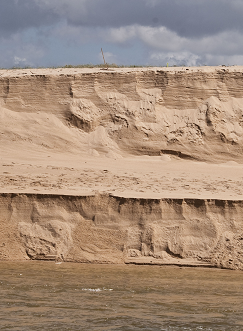Current Research
Long-term coastal adaptation
After several years focusing on the sedimentary record and tentatively linking this to climate variability and/or human activities, I will focus in the future on quantitatively resolving the environmental conditions and mechanisms behind episodic destruction/reconstruction of coastal barriers under extreme climate events at centennial-to-millennial time scale.
Future research builds upon a significant database on coastal adaptation and evolution for the past 6000 years. The database includes information on shoreline progradation, barrier formation and inland sand transference through the formation of transgressive dunes collected in the frame of the research project SCARPS. The idea within this framework is to test our ability of integrating multi-scale simulations aimed at reconstructing the Holocene morphogenesis and evolution of coastal barriers, considering representative climatic driving conditions in order to transform speculative explanations onto physical processes linked to realistic parameter sets.
Recent investigations along the Portuguese coast document complex histories of barrier evolution including episodic destruction/reconstruction over the last 6000 years (Costas et al. 2012, Costas et al. 2013, Costas et al. 2015). Examples of such episodic evolution were documented along the Portuguese coast at Costa da Caparica, Quiaios-Mira and Tròia. Fig. 1 summarizes the major episodes that characterized the evolution of the coast at Costa da Capararica since the Mid-Holocene. In this case, cliff-top dunes were hypothetically linked to the formation of transgressive dunes migrating inland from a former shoreline in a context of shoreline retreat (Costas et al. 2012). The latter was related to disturbances on the sediment budget likely induced by enhanced storminess, a relative sea-level rise or changes in the sediment input. Interestingly, the formation of cliff-top dunes at this site repeated until recent times (Late-Holocene) when the sand ramp was dismantled and a new sand barrier was built at the base of the eroded cliff (Fig. 1). As shown in Fig. 1, the installation of a new barrier beach was followed by the seaward progradation of the shoreline. The proposed model of evolution supports very young ages for the present sand barrier, and an elevated dynamism at this site.

As it has been aforementioned, this episodic nature of the coast has been also documented at Quiaios (Fig. 2) and at Tròia peninsula (Costas et al. 2015). Yet, despite the episodes of barrier progradation and elongation and retreat (identified by the formation of large blowouts and parabolic transgressive dunes) identified at Tròia, the record suggests that this barrier was not entirely dismantled during its evolution, which extends over the last 6.500 years.
The above raises several questions regarding the evolution of coastal barriers in terms of genesis/destruction/rebuilding and very importantly, about the major factors driven those. The three examples show a gradiente on the age of their formation with the barrier located in Quiaios (open coast) as being the youngest, followed by the Caparica and finally the Tròia coastal barrier. The two last sites show significant similarities in terms of beach plan shape as both represent embayed coastal barriers formed to the south of the Tagus and Sado gigant ebb-deltas respectively. In this regard, similar trends would be expected for both, however why did they evolve so differently?

Additionally, the elevated abundance of transgressive dunes found within the explored coastal systems, supports the aeolian transference of sand inland as a major and effective driver of shoreline retrogradation. The latter highlights the importance of including aeolian sediment transport and deposits on any effort of quantitatively explore long-term evolution of coastal systems.
The observed trends have been tentatively related to climate variability (i.e. wind and wave shifts) and could significantly contribute to decision-making process by minimizing uncertainties about the severity of climate-change impacts over coastal barriers. However, our ability to simulate barrier evolution by integrating over multiple storm events and including post-storm recovery and fair weather action remains far from being resolved (Lorenzo-Trueba and Ashton, 2014). In this regard, recent works have shown promising results attempting to study the long-term morphological evolution of wave-dominated coasts on a centennial-to-millennial scale by integrating multi-scale hybrid morphodynamic models and representative climatic driving conditions (Zhang et al. 2014).
More questions...
> Was barrier destruction a result of the cumulative effect of erosive conditions driven by changes in wind/wave climate, sediment supply or tsunami impact?
> Can we reproduce/simulate the cumulative effect of those conditions?
> Can we reproduce coastal adaptation to long-term environmental/climate conditions?
> How far back in time can we go?
So far...
We have coupled the XBeach model in a stand-alone mode with a simple model describing dune sedimentation. Coupled models would represent not only beach profile evolution but also sediment exchange with the adjacent dune, and the eventual growth of the dune that was missing in previous versions of the XBeach. Thus, once models are coupled a series of successive events of diverse characteristics (storm waves, fair weather waves, tsunamis) in order to test our capacity of reproducing the sedimentary record within a sand barrier (Roelvink and Costas, 2015).

Contact info:
Centro de Inv. Marinha e Ambiental - CIMA
Universidade do Algarve
Campus de Gambelas, Edifício 7
8005-139 Faro PORTUGAL
+351 289 800900 (ext. 7898)
E-mail: scotero@ualg.pt
